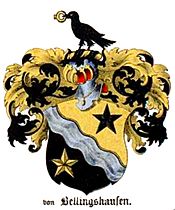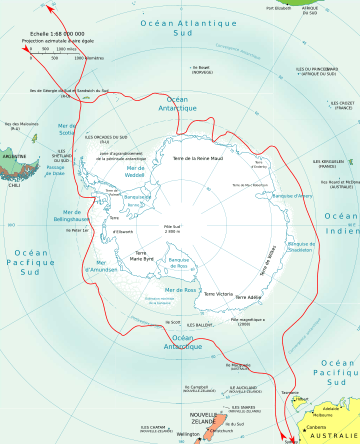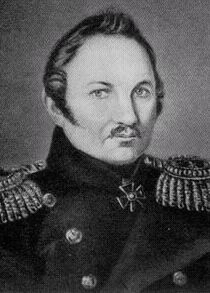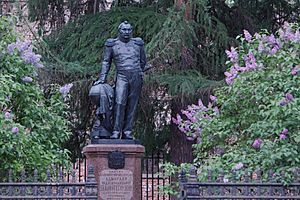Fabian Gottlieb von Bellingshausen facts for kids
Quick facts for kids
Fabian Gottlieb von Bellingshausen
|
|
|---|---|

Admiral Fabian Gottlieb von Bellingshausen, lithograph by U. Schzeibach (У. Шзейбах), circa 1835
|
|
| Born | 20 September [O.S. 9 September] 1778 Lahhentagge Manor, Lahhentagge, Kreis Ösel, Riga Governorate, Russian Empire (in present-day Lahetaguse, Saare County, Estonia) |
| Died | 25 January [O.S. 13 January] 1852 (aged 73) Kronstadt, St. Petersburg, Russian Empire |
| Allegiance | |
| Service/ |
|
| Years of service | 1795–1852 |
| Rank | Admiral |
| Battles/wars | Russo-Turkish War (1828–1829) |
| Awards | Order of Saint George Order of Saint Vladimir |
Fabian Gottlieb Thaddeus von Bellingshausen (Russian: Фадде́й Фадде́евич Беллинсга́узен, romanized: Faddéj Faddéevič Bellinsgáuzen; 20 September [O.S. 9 September] 1778 – 25 January [O.S. 13 January] 1852) was a Russian naval officer, cartographer and explorer, who ultimately rose to the rank of admiral. He participated in the First Russian circumnavigation of the globe and subsequently became a leader of another circumnavigation expedition that discovered the continent of Antarctica. Like Otto von Kotzebue and Adam Johann von Krusenstern, Bellinghausen belonged to the cohort of prominent Baltic German navigators who helped Russia launch her naval expeditions.
Bellingshausen was born on Osel Island. He started his service in the Russian Baltic Fleet, and after distinguishing himself joined the First Russian circumnavigation of the Earth in 1803–1806, serving on the merchant ship Nadezhda under the captaincy of Adam Johann von Krusenstern. After the journey he published a collection of maps of the newly explored areas and islands of the Pacific Ocean. Subsequently, he commanded several ships of the Baltic and Black Sea Fleets.
As a prominent cartographer, Bellingshausen was appointed to command the Russian circumnavigation of the globe in 1819–1821, intended to explore the Southern Ocean and to find land in the proximity of the South Pole. Mikhail Lazarev prepared the expedition and was made Bellingshausen's second-in-command and the captain of the sloop Mirny, while Bellingshausen himself commanded the sloop Vostok. During this expedition Bellingshausen and Lazarev became the first explorers to see the land of Antarctica on 27 January 1820 (New Style). They circumnavigated the continent twice and never lost each other from view. Thus they disproved Captain Cook's assertion that it was impossible to find land in the southern ice-fields. The expedition discovered and named Peter I Island, Zavodovski, Leskov and Visokoi Islands, the Antarctic Peninsula and Alexander Island (Alexander Coast), and made other discoveries in the tropical waters of the Pacific.
Made counter admiral on his return, Bellingshausen participated in the Russo-Turkish War of 1828–1829. Promoted to vice-admiral, he again served in the Baltic Fleet in 1830s, and from 1839 he was the military governor of Kronstadt, where he died. In 1831 he published the book on his Antarctic travels, called Double Investigation of the Southern Polar Ocean and the Voyage Around the World (Двукратные изыскания в южнополярном океане и плавание вокруг света). Russians remember him as one of their greatest admirals and explorers. Multiple geographical features and locations in the Antarctic, named in honor of Bellingshausen, commemorate his role in the exploration of the southern polar region.
Contents
Early life and career
Bellingshausen was born to a Baltic German noble Bellingshausen family in the Lahhentagge manor, Ösel County in the Governorate of Livonia of the Russian Empire; now Saare County, Estonia. His paternal family had Holsteinish origins, the surname Bellingshausen was first recorded in Lübeck. He enlisted as a cadet in the Imperial Russian Navy at the age of ten. After graduating from the Kronstadt naval academy at age eighteen, Bellingshausen rapidly rose to the rank of captain.

A great admirer of Cook's voyages, Bellingshausen served from 1803 in the first Russian circumnavigation of the Earth. He was one of the officers of the vessel Nadezhda ("Hope"), commanded by Adam Johann von Krusenstern.
The mission was completed in 1806. After the journey Bellingshausen published a collection of maps of the newly explored areas and islands of the Pacific Ocean.
Service as captain
Bellingshausen's career continued with the command of various ships in the Baltic and Black Seas. From 1812 to 1816 he commanded the frigate ' and from 1817 to 1819 the frigate ', both in the Black Sea Fleet. During 1812 he met on Macquarie island Richard Siddins, the Australian captain of the ship Campbell Macquarie.
First Russian Antarctic expedition
When Emperor Alexander I authorized an expedition to the south polar region in 1819, the authorities selected Bellingshausen to lead it as an experienced captain and explorer, and a prominent cartographer. The expedition was intended to explore the Southern Ocean and to find land in the proximity of the South Pole. The preparation work on the two ships, the 985-ton sloop-of-war Vostok ("East") and the 530-ton support vessel Mirny ("Peaceful") was carried out by Mikhail Lazarev, who had captained his own circumnavigation of the globe before. Bellingshausen became the captain of Vostok, and Lazarev captained Mirny. The journey started from Kronstadt on 4 June 1819. They stopped briefly in England, where Bellingshausen met with Sir Joseph Banks, the president of the Royal Society. Banks had sailed with Captain James Cook fifty years earlier and supplied the Russians with books and charts for their expedition.
Leaving Portsmouth on 5 September 1819 the expedition crossed the Antarctic Circle (the first to do so since Cook) on 26 January 1820 (New Style). On 27 January the expedition discovered the Antarctic mainland approaching the Antarctic coast at a point with coordinates 69º21'28"S 2º14'50"W and seeing ice-fields there. The point in question lies within twenty miles of the Antarctic mainland. Bellingshausen's diary, his report to the Russian Naval Minister on 21 July 1821 and other documents, available in the Russian State Museum of the Arctic and Antarctic in Saint Petersburg, Russia, were carefully compared with the log-books of other claimants by the British polar historian A. G. E. Jones in his 1982 study Antarctica Observed. Jones concluded that Bellingshausen, rather than the Royal Navy's Edward Bransfield on 30 January 1820 or the American Nathaniel Palmer on 17 November 1820, was indeed the discoverer of the sought-after Terra Australis.
During the voyage Bellingshausen also visited Ship Cove in New Zealand, the South Shetland Islands, and discovered and named Peter I, Zavodovski, Leskov and Visokoi Islands, and a peninsula of the Antarctic mainland that he named the Alexander Coast but that has more recently borne the designation of Alexander Island.
Bellingshausen and Lazarev managed to twice circumnavigate the continent and never lost each other from view. Thus they disproved Captain Cook's assertion that it was impossible to find land in the southern ice fields. The expedition also made discoveries and observations in the tropical waters of the Pacific Ocean.
Admiral
Returning to Kronstadt on 4 August 1821, Bellingshausen was made counter admiral. He fought in the Russo-Turkish War of 1828–1829 and attained the rank of vice admiral in 1830. In 1831 he published the book on his Antarctic travel, called Double Investigation of the Southern Polar Ocean and the Voyage Around the World (Двукратные изыскания в южнополярном океане и плавание вокруг света).
Military governor of Kronstadt
He became the military governor of Kronstadt, the naval base at the approaches of St Petersburg, from 1839, and died there in 1852.
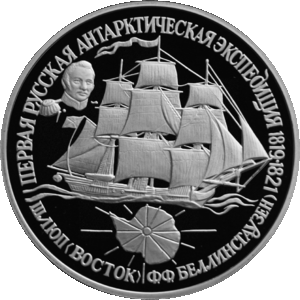
Legacy
Fabian Gottlieb von Bellingshausen is remembered in Russia as one of its greatest admirals and explorers. In the Antarctic, multiple geographical features and locations, named in honor of Bellingshausen, remind of his role in exploration of the southern polar region.
Monuments
There is a memorial stone of Bellingshausen on the previous site (on the ruins) of Lahhentagge/Lahetaguse manor in Ösel/Saaremaa.
There is a monument to Bellingshausen in Nikolayev, Ukraine.
There is a monument to Admiral Bellingshausen in Kronstadt.
Named in honor
- Bellingshausen Island (was) in the Aral Sea.
- Bellingshausen Island in the south Atlantic Ocean, part of the South Sandwich Islands
- Bellingshausen Sea in the Southern Ocean
- Bellingshausen Station, a Russian (former Soviet) base on King George Island, Antarctica
- Bellingshausen Plate, an ancient tectonic plate
- Bellinsgauzen, a crater on the far side of the Moon
- Faddey Islands in the Laptev Sea coastal region, named after Bellingshausen's first name in Russian
- Motu One (Society Islands), also known as Bellinghausen, an atoll in the Pacific Ocean
- A minor planet 3659 Bellingshausen, discovered by Soviet astronomer Lyudmila Chernykh in 1969
See also
 In Spanish: Fabian Gottlieb von Bellingshausen para niños
In Spanish: Fabian Gottlieb von Bellingshausen para niños


